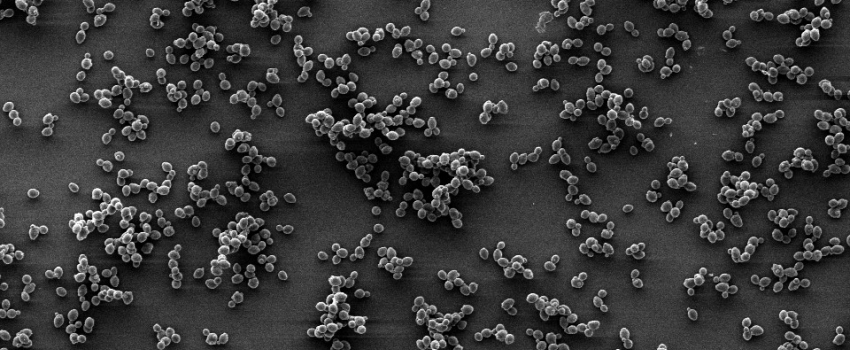
The extraordinary & infinite world of non-Saccharomyces yeast
Publiée le 10/02/2020 11:34Although non-Saccharomyces yeasts have long been considered harmful to alcoholic fermentation, nowadays research associates these strains with a real potential for differentiating wines. Progress in the field of molecular biology has led to the discovery of the roles played by various non-Saccharomyces yeasts. Their impact on the final composition of wine is very interesting, as they are able to enhance the complexity of the aroma profile of wines. Some can enrich the must in metabolites that have a positive impact on the aroma profile of the wine. By identifying them and studying their metabolisms from the vine to the wine, we have established the fundamental rules of the transformation of must and the contribution of microorganisms to the quality of wine.
Context
The microflora of grapes and musts forms a complex biological system where a great variety of bacteria, yeasts and other fungi interact in multiple ways. The fermentation of grape must is a complex microbial process, involving sequential development of various yeast communities, each affected by physico-chemical conditions (pH, sugar concentration, etc.) and the vinification process (temperature, SO2 content, etc.). Although the process has not changed since ancient times, at the end of the 19th century – thanks to the research on microorganisms and fermentation by Charles Cagniard de La Tour (1838) and, of course, Louis Pasteur (1860, 1867) – empiricism yielded to modernism and the development of the first techniques to control winemaking. Since then, our knowledge of wine microorganisms has surged.
The ecology of wine yeast
The microbial consortium depends above all on its environment – the conditions of the climate, soil, grapevine and terroir. It evolves over time, during the ripening of the grapes, in the must and during alcoholic fermentation.
Certain species are omnipresent while others develop only in very special conditions. The study of these different microbial populations has brought us to understand the precise interactions among different microorganisms during fermentation.
The majority of yeasts present on the grape berry, including Aureobasidium pullulans, Hanseniaspora, Metschnikowia, Pichia, Candida, Debaryomyces hansenii, Cryptococcus, Kloeckera and Bulleromyces, have pectolytic, cellulolytic or oxidative activity. Saccharomyces and other fermentative yeast species are nearly undetectable at this stage of development.
In the must, the species that predominate on the grapes up to that point yield to the fermentative species, principally apiculate yeasts, such as Kloeckera, Hanseniaspora, Candida, Torulaspora and Metschnikowia, as well as Saccharomyces cerevisiae-type yeasts, which are crucially important. Apiculate yeasts are present at the start of spontaneous alcoholic fermentation, despite their limited fermentation capacity. Indeed, these species present a low tolerance for alcohol, are cryophilic and can produce acetic acid and ethyl acetate in large quantities. Saccharomyces is the species that adapts best to difficult conditions in the must and is the one most likely to transform it into wine.
Details of the principal microbial phases of vinification are given below:
1. Pre-fermentation phase: The non-Saccharomyces”yeasts generally dominate the grape must and produce precursors and aromatic compounds during this phase. This phase can be dangerous for alcoholic fermentation if these yeasts deplete the medium of its nutrients and produce large quantities of compounds that are undesirable for varietal and “terroir” expression.
2. Fermentation phase: Saccharomyces is dominant as it is the best-adapted species for using sugars, at the same time it also produces fermentation aromas (largely derived from precursors that are present in the must).
3. Maturation phase: when the spoilage apiculate yeasts look for opportunities to grow.
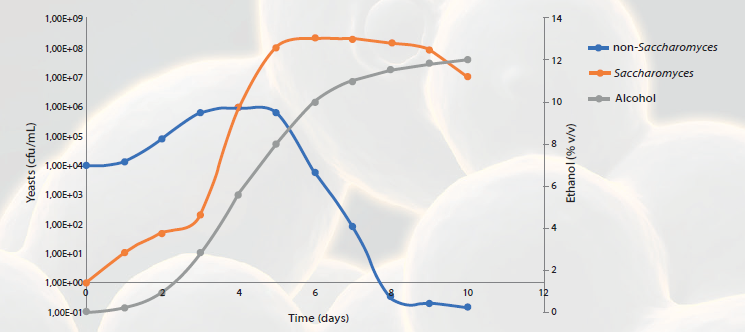
Yeast population dynamics during AF
Non-Saccharomyces yeasts and their role in winemaking
What kind of microorganisms are found and where?
We hear many stories about natural fermentation and the indigenous yeasts found in the terroir (vineyard) site that will help give the wine a better representation of what the wine should be. It is actually very hard to find fermenting yeast on healthy berries, and most of them like to be associated with human activities (winery) where sugars are readily available and they are quite opportunists. They are often also associated with insects (wasps, fruit flies). These populations will change and evolve based on different factors such as hygiene (cleaning) and temperature.
Limited number of yeasts participate in winemaking. The yeast indeed need to adapt to low pH (< 3 -4), high initial sugar concentration (> 150 g/L), low oxygen and increasing ethanol concentration > 15 % v/v.
Which yeast participate in this process?
- Oxidative Yeast (with a limited metabolic activity) - Metschnikowia, Issatchenkia
- Weak fermenters (early stage of AF) - Hanseniaspora, Torulaspora, Lachancea, Debaryomyces
- Strong fermenters - Saccharomyces
We already said that non-Saccharomyces yeasts are particularly active during the pre-fermentation phase. This under-exploited period allows the non-Saccharomyces yeasts to reveal precursors and aromatic compounds in must.
During spontaneous fermentation, actual microbial population dynamics result in successions of enzyme activity that undoubtedly contribute, positively or negatively, to the aromatic complexity and diversity of the wine.
At Lallemand Oenology, when we select a new yeast, we start from the fact that there must be a positive interaction between the non-Saccharomyces yeast and the Saccharomyces so that AF can proceed smoothly with the benefit of the non-Saccharomyces to wine, without inhibiting the work of Saccharomyces to complete AF, and not cause aromatic deviation.
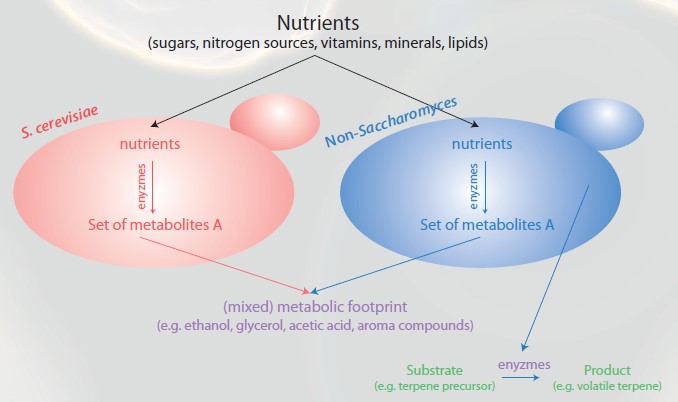
Positive interactions between non-Saccharomyces and Saccharomyces
After years of R&D, Lallemand is proud to now produce 4 non-Saccharomyces yeast strains among those species :
- Metschnikowia pulcherrima (Flavia™) - Optimal release of aroma precursors through specific enzymatic activity: enhancement of varietal aromas
- Torulaspora delbrueckii (Biodiva™) - Enhancement of aromatic complexity and mouthfeel; low acetic acid production in natural sweet wines
- Metschnikowia fructicola (Gaïa™) - Bioprotection in red wines during prefermentative steps
- Lachancea thermotolerans (Laktia™) - Natural acidification and freshness improvement through lactic acid production
They are all intended for use in sequential inoculation with a paired Saccharomyces cerevisiae strain, enabling winemakers to impact the sensory qualities and complexity of their wine while ensuring a reliable and complete fermentation.
Besides, not only has it now been shown that the “non-conventional yeast” contribute to the sensory profile of wines, but they can also play the role of a natural biocontrol agent during pre-fermentation stage. Indeed, Gaïa™ (Metschnikowia fructicola) or Biodiva™ (Torulaspora delbrueckii), for instance, help suppress the growth of undesirable population of acetic acid producing yeast, such as Kloeckera apiculata or Hanseniaspora uvarum, when used in picking bins or during cold soaking.
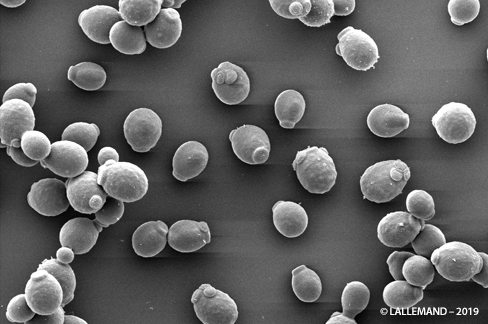
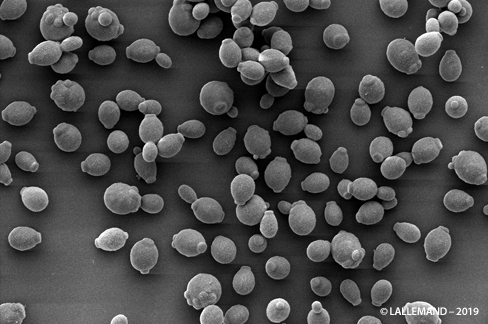
Conclusion
Although winemakers have multiple objectives, their primary objective is always to produce quality wine with consistent typicity that meets the expectations of the consumer, and to do so in accordance with an operation that is sustainable and secure. The wine must respect sensory criteria for quality, i.e., aromatic intensity, complexity, clarity and freshness, in addition, of course, to being pleasant to drink.
The challenge for the producer is to offer the consumer wine whose distinctive character and typicity are maintained while practicing secure fermentation in order to protect the product from sensory deviations, contamination and other fermentation problems that can harm its quality. Fortunately, the producer can now count on a range of non-Saccharomyces and Saccharomyces yeast solutions for aromatic diversification and to maintain typicity while benefiting from the security and mastery of the fermentation process that active dry yeasts now offer.
What’s next?
The uniqueness of yeasts offers infinite possibilities because of the amazing diversity of behaviors and metabolisms. At Lallemand Oenology, we can foresee fascinating findings for new oenological applications that will completely transform the art and the craft of winemaking. No doubt that in the years to come, we will be offering winemakers new selected non-Saccharomyces yeasts to help them adapt to the evolution of consumption habits for instance and mitigate the impact of climate change on their wines.


